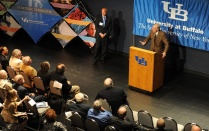Lindqvist studies paleogenome continuity in Southeast Alaska

Charlotte Lindqvist, associate professor, Department of Biological Sciences
The peer-reviewed, open-access journal, iScience, has published a paper by UB evolutionary biologist Charlotte Lindqvist and collaborators, “A paleogenome from a Holocene individual supports genetic continuity in Southeast Alaska." Their findings show, using ancient genetic data analyses, that some modern Alaska Natives still live almost exactly where their ancestors did some 3,000 years ago. In addition to Lindqvist, authors of the new paper include Alber Aqil, Stephanie Gill, Omer Gokcumen, Ripan Malhi, Esther Aaltséen Reese, Jane Smith, and, Timothy Heaton. The research was funded by the National Science Foundation. Read more.
research news
Searching for ancient bears in Alaskan cave led to important human discovery

The bone that researchers found belonged to an ancient individual that the Wrangell Cooperative Association named Tatóok yík yées sháawat (Young lady in cave). Credit: University at Buffalo
By MARY DURLAK
Published May 3, 2023
The first people to live in the Americas migrated from Siberia across the Bering land bridge more than 20,000 years ago. Some made their way as far south as Tierra del Fuego, at the tip of South America. Others settled in areas much closer to their place of origin where their descendants still thrive today.
In “A paleogenome from a Holocene individual supports genetic continuity in Southeast Alaska,” published April 21 in the journal iScience, UB evolutionary biologist Charlotte Lindqvist and collaborators show, using ancient genetic data analyses, that some modern Alaska Natives still live almost exactly where their ancestors did some 3,000 years ago.
Lindqvist, associate professor of biological sciences, College of Arts and Sciences, is senior author of the paper. In the course of her studies in Alaska, she explored mammal remains that had been found in a cave in the state’s southeast coast. One bone was initially identified as coming from a bear. However, genetic analysis showed it to be the remains of a human female.
“We realized that modern Indigenous peoples in Alaska, should they have remained in the region since the earliest migrations, could be related to this prehistoric individual,” says Alber Aqil, a UB PhD student in biological sciences and the first author of the paper. This discovery led to efforts to solve this mystery, which DNA analyses are well suited to address when archaeological remains are as sparse as these were.
Learning from an ancestor
The earliest peoples had already started moving south along the Pacific Northwest Coast before an inland route between ice sheets became viable. Some, including the female individual from the cave, made their home in the area that surrounds the Gulf of Alaska. That area is now home to the Tlingit Nation and three other groups: Haida, Tsimshian and Nisga’a.
As Aqil and colleagues analyzed the genome from this 3,000-year-old individual — “research that was not possible just 20 years ago,” Lindqvist notes — they determined that she is most closely related to Alaska Natives living in the area today. This fact showed it was necessary to carefully document as clearly as possible any genetic connections of the ancient female to present-day Native Americans.
In such endeavors, it is important to collaborate closely with people living in lands where archaeological remains are found. Therefore, cooperation between Alaska Native peoples and the scientific community has been a significant component of the cave explorations that have taken place in the region. The Wrangell Cooperative Association named the ancient individual analyzed in this study as “Tatóok yík yées sháawat” (Young lady in cave).
Genetic continuity persists for thousands of years
Indeed, Aqil and Lindqvist’s research demonstrated that Tatóok yík yées sháawat is in fact closest related to present-day Tlingit peoples and those of nearby tribes along the coast. Their research therefore strengthens the idea that genetic continuity in Southeast Alaska has continued for thousands of years.
Human migration into North America, although it began some 24,000 years ago, came in waves — one of which, about 6,000 years ago — included the Paleo-Inuit, formerly known as Paleo-Eskimos. Importantly for understanding Indigenous peoples’ migrations from Asia, Tatóok yík yées sháawat’s DNA did not reveal ancestry from the second wave of settlers, the Paleo-Inuit. Indeed, the analyses performed by Aqil and Lindqvist helped shed light on the continuing discussion of migration routes, mixtures among people from these different waves, as well as modern territorial patterns of inland and coastal people of the Pacific Northwest in the pre-colonial era.
The oral origin narratives of the Tlingit people include the story of the most recent eruption of Mount Edgecumbe, which would place them exactly in the region by 4,500 years ago. Tatóok yík yées sháawat, their relative, therefore informs not just modern-day anthropological researchers but also the Tlingit people themselves.
Out of respect for the right of the Tlingit people to control and protect their cultural heritage and their genetic resources, data from the study of Tatóok yík yées sháawat will be available only after review of its use by the Wrangell Cooperative Association Tribal Council.
“It’s very exciting to contribute to our knowledge of the prehistory of Southeast Alaska,” says Aqil.
The research was funded by the National Science Foundation. In addition to Lindqvist and Aqil, authors of the new paper in iScience include Stephanie Gill, Omer Gokcumen, Ripan S. Malhi, Esther Aaltséen Reese, Jane L. Smith and Timothy T. Heaton.
Faculty Profile
![Charlotte Lindqvist.]()
Charlotte Lindqvist
PhD
Research Interests
Evolutionary biology; molecular phylogenetics and population genomics
Education
PhD University of Copenhagen, Denmark
Postdoctoral Research at University of Oslo, NorwayResearch Summary
Research in the Lindqvist Lab is broadly concerned with the evolutionary genetic basis of diversification in natural populations and environments to better understand the processes of speciation and the impact of hybridization/admixture, and responses to global environmental perturbations in both animals and plants. My research uses genetic/genomic and metagenomic analyses of modern and historical/ancient material (ancient DNA) to address longstanding questions in the evolutionary history of mammals and flowering plants. Current projects include paleogenetic surveys of Late Quaternary subfossil biodiversity and lake sediments in Southeast Alaska, evolutionary genomics of Arctic and boreal carnivore mammals (with a focus on ursine bears and mustelids), and population genomics/phylogenomics of several angiosperm radiations.
Selected Publications
- Tomlin CM, Rajaraman S, Sebesta JT, Scheen A-C, Bendiksby M, Low YW, Salojärvi J, Michael TP, Albert VA, Lindqvist C (2024) Allopolyploid origin and diversification of the Hawaiian endemic mints. Nature Communications 15 (1):3109. doi:10.1038/s41467-024-47247-y
- Saul F, Scharmann M, Wakatake T, Rajaraman S, Marques A, Freund M, Bringmann G, Channon L, Becker D, Carroll E, Low YW, Lindqvist C, Gilbert KJ, Renner T, Masuda M, Richter M, Vogg G, Shirasu K, Michael TP, Hedrich R, Albert VA, Fukushima K. Subgenome dominance shapes novel gene evolution in the decaploid pitcher plant Nepenthes gracilis. Nature Plants. 2023 Nov 23:1-6.
- Silva Coelho, F.A., Gill, S., Tomlin, C.M., Papavassiliou, M., Farley, S.D., Cook, J., Sonsthagen, S., Sage, G.K., Heaton, T.H., Talbot, S.L., Lindqvist, C. (2023) Ancient bears provide insights into Pleistocene ice age refugia in Southeast Alaska. Molecular Ecology, 00, 1 16.
- Aqil, M.A., Gill, S., Gokcumen, O., Malhi, R.S., Reese, E.A., Smith, J.L., Heaton, T.H., Lindqvist, C. (2023) A Paleogenome from a Southeast Alaska Holocene individual supports genetic continuity, archeological records, and Tlingit oral history. iScience 26 (5): 106581.
- Low YW, Rajaraman S, Tomlin CM, Ahmad JA, Ardi WH, Armstrong K, Athen P, Berhaman A, Bone RE, Cheek M, Cho NRW, Choo LM, Cowie ID, Crayn D, Fleck SJ, Ford AJ, Forster PI, Girmansyah D, Goyder DJ, Gray B, Heatubun CD, Ibrahim A, Ibrahim B, Jayasinghe HD, Kalat MA, Kathriarachchi HS, Kintamani E, Koh SL, Lai JTK, Lee SML, Leong PKF, Lim WH, Lum SKY, Mahyuni R, McDonald WJF, Metali F, Mustaqim WA, Naiki A, Ngo KM, Niissalo M, Ranasinghe S, Repin R, Rustiami H, Simbiak VI, Sukri RS, Sunarti S, Trethowan LA, Trias-Blasi A, Vasconcelos TNC, Wanma JF, Widodo P, Wijesundara DSA, Worboys S, Yap JW, Yong KT, Khew GSW, Salojärvi J, Michael TP, Middleton DJ, Burslem DFRP, Lindqvist C, Lucas EJ, Albert VA. Genomic insights into rapid speciation within the world’s largest tree genus Syzygium. Nature Communications. 2022 Sep 12, 13(1):5031.
- Lan, T., Leppälä, K., Tomlin, C., Talbot, S.L., Sage, G.K., Farley, S.D., Shideler, R.T., Bachmann, L., Wiig, Ø., Albert, V.A., Salojärvi, J., Mailund, T., Drautz-Moses, D.I., Schuster, S.C., Herrera-Estrella, L., Lindqvist, C. (2022). Insights into bear evolution from a Pleistocene polar bear genome. Proceedings of the National Academy of Sciences, USA 119 (24) e2200016119.
- Kosintsev, P.A., Bocherens, H., Kirillova, I.V., Levchenko, V.A., Zazovskaya, E.P., Trofimova, S.S., Lan, T., Lindqvist, C.* (2022) Palaeoecological and genetic analyses of Late Pleistocene bears in Asiatic Russia. Boreas 51: 465–480.
- da Silva Coelho FA, Gill S, Tomlin CM, Heaton TH, Lindqvist C. (2021) An early dog from southeast Alaska supports a coastal route for the first dog migration into the Americas. Proceedings of the Royal Society B 288(1945):20203103.
- Lindqvist, C. & Rajora, O.P. (Eds.) 2019. Paleogenomics. Genome-Scale Analysis of Ancient DNA. Springer Nature.
- Lesnek, A.J., Briner, J.P., Lindqvist, C., Baichtal, J.F., Heaton, T.H. (2018). Deglaciation of the Pacific coastal corridor and the human colonization of the Americas. Science Advances 4: 5.
- Lan, T., Gill, S., Bellemain, E., Bischof, R., Nawaz, M.A., Lindqvist, C. (2017). Evolutionary history of enigmatic bears in the Tibetan Plateau-Himalaya Region and the identity of the Yeti. Proceedings of the Royal Society B 284: 20171804.
- Welch, A.J., Hofer, K., Ratan, A., Drautz, D., Schuster, S.C., Lindqvist, C. (2016) The quest to resolve recent radiations: Plastid phylogenomics of extinct and endangered Hawaiian endemic mints (Lamiaceae). Mol Phyl Evol 99: 16-33.
- Miller, W., Schuster, S.C., Welch, A.J., Ratan, A., Bedoya-Reina, O.C., Zhao, F., Kim, H.L., Burhans, R.C., Drautz, D.I., Wittekindt, N.E., Tomsho, L.P., Ibarra-Laclette, E., Herrera-Estrella, L., Peacock, E., Farley, S., Sage, G.K., Rode, K., Obbard, M., Montiel, R., Bachmann, L., Ingólfsson, Ó., Aars, J., Mailund, T., Wiig, Ø., Talbot, S.L., Lindqvist, C. (2012). Polar and brown bear genomes reveal ancient admixture and demographic footprints of past climate change. Proc Natl Acad Sci, USA 109(36): E2382-E2390.
- Lindqvist, C., Schuster, S.C., Sun, Y., Talbot, S.L., Qi, J., Ratan, A. Tomsho, L.P., Kasson, L., Zeyl, E., Aars, J., Miller, W., Ingolfsson, O., Bachmann, L., Wiig, Ø (2010). Complete mitochondrial genome of a Pleistocene jawbone unveils the origin of polar bear. Proc Natl Acad Sci, USA 107: 5053-5057.
- Scheen, A.-C., Bendiksby, Ryding, O., , Mathiesen, C., Albert, V.A., Lindqvist, C. (2010). Molecular phylogenetics, character evolution, and suprageneric classification of Lamioideae (Lamiaceae). Annals Miss Bot Gard 97: 191-218.
- Lindqvist, C., Albert, V.A. (2002). Origin of the Hawaiian endemic mints within North American Stachys (Lamiaceae). Am J Bot 89: 1709-1724.


